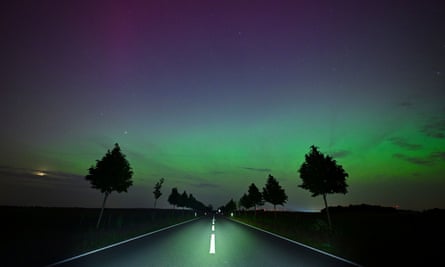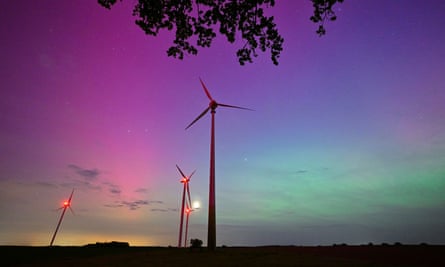11.05.2024

Aurora borealis sightings further south than usual from Ireland and Britain to Czech Republic and Germany as solar storm hits Earth’s atmosphere
The aurora borealis has lit up the night sky with rare sightings across the UK, Europe and the northern hemisphere.
The northern lights were spotted in Whitley Bay on the north-east coast; Essex; Cambridgeshire; and Wokingham in Berkshire. They were also sighted in Suffolk, Kent, Hampshire and Liverpool.
Kathleen Cunnea, in Great Horkesley, Essex, said: “It was absolutely stunning to see.”
Sightings were reported in Ireland, where the weather service Met Éireann posted images of the lights over Dublin and above Shannon airport in County Clare.
Met Office spokesman Stephen Dixon said on Friday: “Although the shorter nights will limit the visibility window, there’s a good chance to see the aurora, particularly on Friday night and especially in Scotland, Ireland and parts of northern England and Wales.
“There could even be visibility further south if you have the right equipment.
“Those conditions could continue on Saturday night but we still have to work out some details on where exactly that will be.”
Dixon said the combination of clear skies and enhanced activity from the sun reaching Earth would improve the chances of seeing the display.
“I feel like I am having a religious experience – or an alien abduction. Not sure which,” science teacher David Boyce tweeted from England. Another user shared a photo and said Edinburgh in Scotland felt like “a different planet tonight”.
Aurora displays occur when charged particles collide with gases in the Earth’s atmosphere around the magnetic poles.
In the northern hemisphere, most of this activity takes place within a band known as the aurora oval, covering latitudes between 60 and 75 degrees. When activity is strong, this expands to cover a greater area – which is why displays can be occasionally seen further south.
In the US, the National Oceanic and Atmospheric Administration (Noaa) issued a rare severe geomagnetic storm warning on Friday. It alerted operators of power plants and spacecraft in orbit to take precautions. Noaa said the storm could produce northern lights as far south as Alabama and northern California.
“For most people here on planet Earth, they won’t have to do anything,” said Rob Steenburgh, a scientist with Noaa’s space weather centre. “That’s really the gift from space weather – the aurora.”
The “very rare event” is being caused by a large sunspot cluster that has produced several moderate to strong solar flares since Wednesday morning, Noaa said. That meant the lights could be seen further south than usual.
Steenburgh and his colleagues said the best aurora views might come from phone cameras, which were better at capturing light than the naked eye.
Even when the storm is over, signals between GPS satellites and ground receivers could be scrambled or lost, according to Noaa. But there are so many navigation satellites that any outages should not last long, Steenburgh said.
It is all part of the solar activity that’s ramping up as the sun approaches the peak of its 11-year cycle.
The storm is anticipated to peak as at least seven coronal mass ejections converge and race towards Earth late on Friday or early on Saturday, according to an update from Noaa. But geomagnetic storming was “highly likely” to persist through the weekend, the agency said.
Experts suggest finding a location with minimal light pollution and looking north for the best sightings of the aurora borealis. But many of the enthused viewers who shared sightings on social media did not have to look hard at all.
“Pictures of everybod[y]’s #aurora experience is the best, most wholesome thing I’ve seen on Twitter in a long time,” one user wrote, calling the experience “magic”. “Everybody just coming together to appreciate nature.”
Nasa said the storm posed no serious threat to the seven astronauts aboard the International Space Station. The biggest concern was increased radiation levels, and the crew could move to a better shielded part of the station if necessary, according to Steenburgh.
Increased radiation also could threaten some of Nasa’s science satellites. Extremely sensitive instruments would be turned off if necessary to avoid damage, said Antti Pulkkinen, director of the space agency’s heliophysics science division. Several sun-focused spacecraft were monitoring all the action.
“This is exactly the kinds of things we want to observe,” Pulkkinen said.
Quelle: The Guardian








